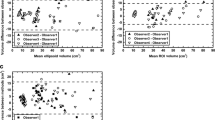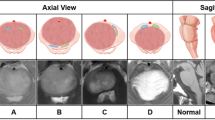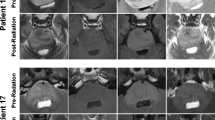Abstract
Background
Diffuse pontine glioma is a pediatric brain tumor with a median survival time of 1 year and few long-term survivors. Conventional MRI has not been shown to predict overall survival. With this dismal prognosis, clinical improvement after radiation therapy might be a more relevant issue.
Objective
To determine whether initial imaging would predict clinical response.
Materials and methods
We performed a retrospective review of children with diffuse pontine glioma treated at The Children’s Hospital, Denver, and the University of Colorado–Denver from 1995 to 2008. The 30 children were divided into two groups based on acute clinical response to radiation therapy. Quantitative measurements on presenting MRIs were compared between the groups.
Results
Seven of 30 children did not respond to radiation therapy. There were no statistically significant differences in initial imaging characteristics between responders and non-responders. Necrosis and enhancement were more common in responders. Tumor surrounding the basilar artery, compression of the 4th ventricle and extension to the cerebellum were more common in non-responders.
Conclusion
Conventional MRI at presentation does not predict clinical response in children with diffuse pontine glioma. Additional studies with larger numbers of patients and other imaging modalities are needed.


Similar content being viewed by others
References
Packer RJ, Boyett JM, Zimmerman RA et al (1993) Hyperfractionated radiation therapy (72 Gy) for children with brain stem gliomas. A Childrens Cancer Group Phase I/II Trial. Cancer 72:1414–1421
Freeman CR, Krischer JP, Sanford RA et al (1993) Final results of a study of escalating doses of hyperfractionated radiotherapy in brain stem tumors in children: a pediatric oncology group study. Int J Radiat Oncol Biol Phys 27:197–206
Mandell LR, Kadota R, Freeman C et al (1999) There is no role for hyperfractionated radiotherapy in the management of children with newly diagnosed diffuse intrinsic brainstem tumors: results of a pediatric oncology group phase III trial comparing conventional vs. hyperfractionated radiotherapy. Int J Radiat Oncol Biol Phys 43:959–964
Korones DN, Fisher PG, Kretschmar C et al (2008) Treatment of children with diffuse intrinsic brain stem glioma with radiotherapy, vincristine and oral VP-16: a children’s oncology group phase II study. Pediatr Blood Cancer 50:227–230
Hargrave D, Chuang N, Bouffet E (2008) Conventional MRI cannot predict survival in childhood diffuse intrinsic pontine glioma. J Neurooncol 86:313–319
Smith RR, Zimmerman RA, Packer RJ et al (1990) Pediatric brainstem glioma. Post-radiation clinical and MR follow-up. Neuroradiology 32:265–271
Moghrabi A, Kerby T, Tien RD et al (1995) Prognostic value of contrast-enhanced magnetic resonance imaging in brainstem gliomas. Pediatr Neurosurg 23:293–298
Laprie A, Pirzkall A, Haas-Kogan DA et al (2005) Longitudinal multivoxel MR spectroscopy study of pediatric diffuse brainstem gliomas treated with radiotherapy. Int J Radiat Oncol Biol Phys 62:20–31
Panigrahy A, Nelson MD Jr, Finlay JL et al (2008) Metabolism of diffuse intrinsic brainstem gliomas in children. Neuro Oncol 10:32–44
Pirotte BJ, Lubansu A, Massager N et al (2007) Results of positron emission tomography guidance and reassessment of the utility of and indications for stereotactic biopsy in children with infiltrative brainstem tumors. J Neurosurg 107:392–399
Fenton LZ, Madden JR, Foreman NK (2003) Brain stem glioma in a child: false diagnosis of radiation necrosis with FDG PET. Med Pediatr Oncol 40:260–262
Bruggers CS, Friedman HS, Fuller GN et al (1993) Comparison of serial PET and MRI scans in a pediatric patient with a brainstem glioma. Med Pediatr Oncol 21:301–306
Janssens GO, Gidding CE, Van Lindert EJ et al (2009) The role of hypofractionation radiotherapy for diffuse intrinsic brainstem glioma in children: a pilot study. Int J Radiat Oncol Biol Phys 73:722–726
Author information
Authors and Affiliations
Corresponding author
Rights and permissions
About this article
Cite this article
Liu, A.K., Brandon, J., Foreman, N.K. et al. Conventional MRI at presentation does not predict clinical response to radiation therapy in children with diffuse pontine glioma. Pediatr Radiol 39, 1317–1320 (2009). https://doi.org/10.1007/s00247-009-1368-5
Received:
Revised:
Accepted:
Published:
Issue Date:
DOI: https://doi.org/10.1007/s00247-009-1368-5




